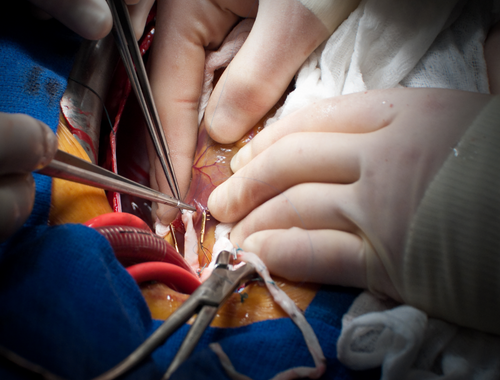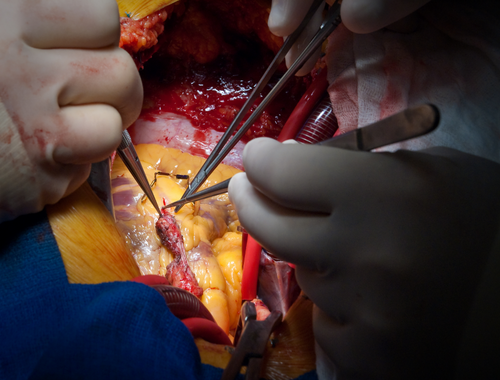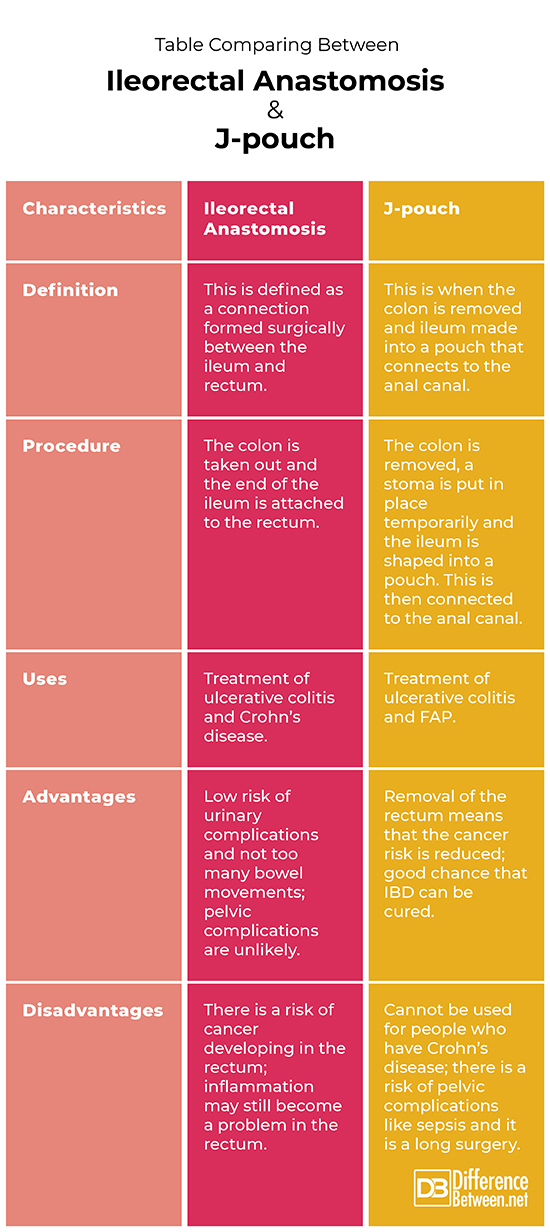Difference Between Ileorectal Anastomosis and J-Pouch
An ileorectal anastomosis is when a surgical connection is made between the ileum and rectum. A J-pouch is when the ileum is made into a pouch and attached to the anal canal.

What is Ileorectal anastomosis?
Definition:
This is a procedure in which the colon is completely cut out of the body and the ileum attached to the rectum.
Procedure:
The procedure is done under general anesthesia and entails complete removal of the colon (colectomy). After this is done the ileum of the small intestine then is attached to the rectum. This connection between the two structures is what is called the anastomosis. The surgery can be done laparoscopically or as an open surgery. A patient often has to take laxatives the day before surgery to clean out the bowel.
Uses:
This procedure is often used to treat ulcerative colitis and Crohn’s disease. It is a way to treat patients with severe inflammatory bowel disease.
Pros:
The procedure has a lower risk of urinary complications compared to a J pouch procedure. The person does not have excess numbers of bowel movements a day after the surgery. There are few (if any) pelvic complications associated with the ileorectal anastomosis procedure.
Cons:
Since the rectum is not removed, there is still a risk of cancer occurring in the rectum. The rectum can also still be a problem in inflammatory bowel disease, so patients may not be fully relieved of their symptoms.

What is J-Pouch?
Definition:
A J pouch is a procedure in which the large intestine is removed and the ileum of the small intestine is made into a pouch.
Procedure:
The procedure involves excising the large intestine, including the rectum. The end of the small intestine, the ileum is then fashioned into a J-shaped pouch. This is then attached to the anus. An ileostomy is done temporarily until the tissues have all healed. This means that patients have a stoma and a bag through which wastes pass. After about 90 days, the ileostomy is reversed and the person is able to pass stool through the anus.
Uses:
The J pouch is a method completed to help treat familial adenomatous polyposis (FAP) and ulcerative colitis. FAP is likely to lead to cancer in the colon so the J pouch is often recommended as a way to reduce this risk.
Pros:
Since the rectum is also removed in this procedure, the risk of cancer is substantially reduced. It also can be a cure for inflammatory bowel diseases such as Crohn’s disease and ulcerative colitis, since the entire section that becomes inflamed (including the rectum) is removed.
Cons:
There is a risk of complications in the pelvic region, including a possibility of pelvic sepsis. The surgery is also a major procedure that takes between 6 to 10 hours. The procedure also can’t be used for treating Crohn’s disease because the pouch can become inflamed.
Difference between Ileorectal anastomosis and J-pouch
Definition
An ileorectal anastomosis is when a connection is made surgically between the ileum and rectum. A J-pouch is when a connection is made surgically between a pouch made out of the ileum and the anal canal.
Procedure
The procedure for an ileorectal anastomosis is the colon is cut out and the end of the ileum is attached to the rectum. The procedure for a J-pouch is the colon is removed, a stoma is put in place temporarily and the ileum is shaped into a pouch. This pouch is then connected to the anal canal.
Uses
An ileorectal anastomosis can be used for treating people who have Crohn’s disease or ulcerative colitis. A J-pouch can be used for treating people who have FADS or ulcerative colitis.
Advantages
The benefits of an ileorectal anastomosis is that there is a reduced risk of urinary or pelvic complications and there are few bowel movements. The benefits of a J-pouch is the risk of rectal cancer is reduced and IBD may be cured.
Disadvantages
The drawbacks of the ileorectal anastomosis is that inflammation and cancer can still occur in the rectum. The drawbacks of the J-pouch is that it can’t be used to treat Crohn’s disease, it is a complicated surgery, and there is a possibility of urinary and pelvic complications.
Table comparing between Ileorectal anastomosis and J-pouch

Summary of difference between Ileorectal anastomosis Vs. J-pouch
- An ileorectal anastomosis and a J-pouch both involve surgery where the colon is removed.
- A J-pouch does not leave the rectum behind but rather attaches the ileum to the anus.
- In the case of an ileorectal anastomosis the ileum is joined to the rectum.
FAQ
What is Ileorectal anastomosis?
An ileorectal anastomosis is when a surgical connection is formed between the ileum and rectum after a colectomy is done.
What is the difference between a J pouch and a colostomy bag?
A J pouch is made inside the body from your small intestine. A colostomy bag is an artificial bag that is attached to the outside of your body at an opening a surgeon creates (the opening is called a stoma); the colostomy bag allows for the passage of stool out the colon.
What is Ileorectal?
Ileorectal is a term referring to both the ileum and the rectum.
What is a J pouch anastomosis?
This is also known as ileoanal anastomosis and is when the colon and rectum are removed and ileum connected to the anus.
- Difference Between Rumination and Regurgitation - June 13, 2024
- Difference Between Pyelectasis and Hydronephrosis - June 4, 2024
- Difference Between Cellulitis and Erysipelas - June 1, 2024
Search DifferenceBetween.net :
Leave a Response
References :
[0]da Luz Moreira, A., R. P. Kiran, and I. Lavery. "Clinical outcomes of ileorectal anastomosis for ulcerative colitis." Journal of British Surgery 97.1 (2010): 65-69.
[1]Joo, Jae Sik, et al. "Long-term functional evaluation of straight coloanal anastomosis and colonic J-pouch." Diseases of the colon & rectum 41.6 (1998): 740-746.
[2]Scoglio, Daniele, Usama Ahmed Ali, and Alessandro Fichera. "Surgical treatment of ulcerative colitis: ileorectal vs ileal pouch-anal anastomosis." World Journal of Gastroenterology: WJG 20.37 (2014): 13211.
